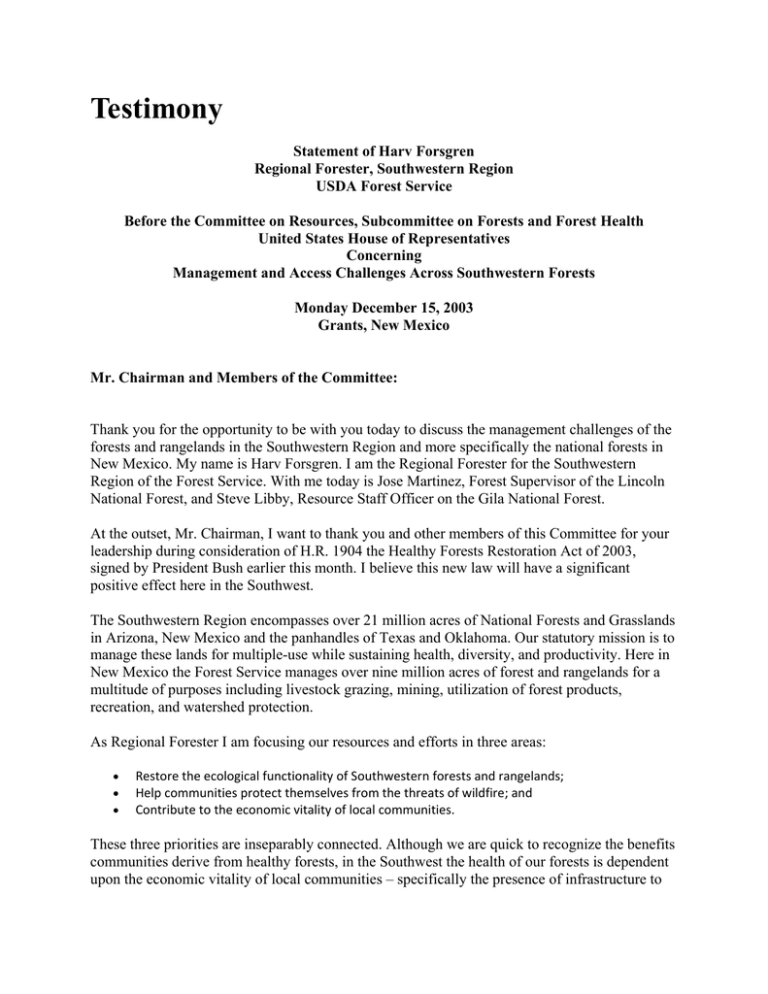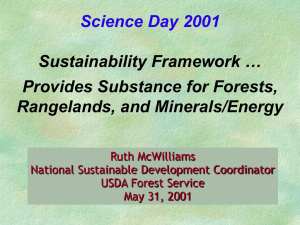Testimony
advertisement

Testimony Statement of Harv Forsgren Regional Forester, Southwestern Region USDA Forest Service Before the Committee on Resources, Subcommittee on Forests and Forest Health United States House of Representatives Concerning Management and Access Challenges Across Southwestern Forests Monday December 15, 2003 Grants, New Mexico Mr. Chairman and Members of the Committee: Thank you for the opportunity to be with you today to discuss the management challenges of the forests and rangelands in the Southwestern Region and more specifically the national forests in New Mexico. My name is Harv Forsgren. I am the Regional Forester for the Southwestern Region of the Forest Service. With me today is Jose Martinez, Forest Supervisor of the Lincoln National Forest, and Steve Libby, Resource Staff Officer on the Gila National Forest. At the outset, Mr. Chairman, I want to thank you and other members of this Committee for your leadership during consideration of H.R. 1904 the Healthy Forests Restoration Act of 2003, signed by President Bush earlier this month. I believe this new law will have a significant positive effect here in the Southwest. The Southwestern Region encompasses over 21 million acres of National Forests and Grasslands in Arizona, New Mexico and the panhandles of Texas and Oklahoma. Our statutory mission is to manage these lands for multiple-use while sustaining health, diversity, and productivity. Here in New Mexico the Forest Service manages over nine million acres of forest and rangelands for a multitude of purposes including livestock grazing, mining, utilization of forest products, recreation, and watershed protection. As Regional Forester I am focusing our resources and efforts in three areas: Restore the ecological functionality of Southwestern forests and rangelands; Help communities protect themselves from the threats of wildfire; and Contribute to the economic vitality of local communities. These three priorities are inseparably connected. Although we are quick to recognize the benefits communities derive from healthy forests, in the Southwest the health of our forests is dependent upon the economic vitality of local communities – specifically the presence of infrastructure to utilize the biomass that must be removed from those forests to restore their health. The most significant land health challenge we face in the Southwest is captured by one startling statistic: Of the 21 million acres of National Forest System lands in the Southwestern Region, more than 80 percent of that acreage is at moderate to high risk of uncharacteristic wildfire. I say “uncharacteristic” not because fire is an unnatural feature of our forests – it is not! Historically, about 85 percent of the landscape burned very frequently, but at low intensity. Rather, I use the word “uncharacteristic” because the current condition of our forests results in fires that are unnaturally large and intense. These fires can severely damage our watersheds. They can alter soils, reducing their ability to capture and hold moisture, accelerating erosion and deteriorating water quality. These fires destroy important wildlife habitats and remnant old growth stands, and hurt visual quality. As we have seen in New Mexico and more recently in southern California, these fires can also destroy lives, property and local economies. Due to effective fire suppression for most of the last century, our Ponderosa Pine forests that were once open and park like, supporting between 50 and 200 trees per acre, are today a dense tangle of up to 2,000 trees per acre. Our forests are literally choking themselves to death. Our current drought is making matters worse. Drought-stressed trees are unable to fend off attacks from insects. The Southwest’s landscape is now blanketed by hundreds of thousands of acres of red…then brown…pinyon and Ponderosa Pine forests killed by insects, further adding to the fire danger. In addition, here in New Mexico over the last 50 years we have lost about one percent of our rangelands each year to pinyon-juniper encroachment, which has adversely affected forage and water availability. And the expansion of the elk population in some areas of the state has resulted in competition for forage which has been limited by woody vegetation encroachment and continued drought. Restoring the health of our forests and rangelands, and securing the associated benefits for future generations will require both active management and naturally occurring wildfire. Simply stated, we need to thin our forests by reducing the total biomass, removing the excess number of trees and carefully reintroducing fire into our forests. The picture I have painted of the challenges we face in restoring forest and grassland health may seem daunting. Nevertheless, I’m very optimistic about our opportunity for success. HealthyForestInitiative One reason for that optimism is the President’s Healthy Forest Initiative. The administrative, regulatory and legislative actions resulting from this focus on active management have given our land managers more tools—including stewardship contracting authority. This is one of the most important conservation initiatives to come along in my career. Given the geographic scale of the “forest health” issue in the Southwest, we cannot effectively address our forest health issues without additional private sector involvement. The Consolidated Appropriations Resolution, 2003 (PL-108-7) contains stewardship contracting authorities that may help facilitate industry investment in infrastucture needed to utilize the small diameter materials that are choking our forests. We will still need to meet the full suite of applicable laws, regulations and policy. We will still need to fund treatments from appropriated funding that won’t pay for themselves, and in the Southwest that will be the rule rather than the exception. But stewardship contracting coupled with the Healthy Forests Restoration Act and other tools provided in the Healthy Forest Initiative will enable us to accomplish more in the future. For all of this work, it is critically important to work collaboratively with local communities and other government agencies. Moreover, stewardship contracting, service contracts, and forage utilization through livestock grazing can provide opportunities for local communities to obtain resources for their use, needs, and for selling to others. Providing Local Assistance Much forest restoration work accomplished in New Mexico is already done cooperatively with the New Mexico Forestry Division and many other Federal, State and local entities. In fiscal year 2003, Region 3 received $33 million dollars for hazardous fuel treatment and treated about 71,000 wildland urban interface acres and about 54000 non-WUI acres. For example, from 2001 though 2003, over $26 million in grants were awarded through our State and Private Forestry Programs. This assistance has been used in helping train and equip rural fire departments. In fiscal year 2003 approximately $525,000 dollars in grants were used to assist over 70 rural fires departments in the Region. In addition, in fiscal year 2003 the Region has assisted in funding of over 600 thinning and watershed restoration projects on non-federal lands. These programs are helping communities protect themselves and are contributing to the economic vitality of these communities. Communities can also help themselves. Citizens can take action through the FIREWISE program, which helps people who live or vacation in fire-prone areas educate themselves about wildland fire protection. Homeowners can learn how to protect their homes with a survivable space and how to landscape their yard with fire resistant materials. A consortium of wildland fire agencies that include the Forest Service, the Department of the Interior, and the National Association of State Foresters sponsor the program. RangelandManagement Another significant management challenge we face in the Southwestern Region is rangeland management. Livestock grazing on national forests and grasslands is a legitimate use of public lands. A healthy livestock industry contributes significantly to community vitality and can help us meet our objectives for healthy rangelands. Although light to moderate precipitation has been received recently over most of Arizona and New Mexico, the ongoing drought continues in the Region. Rangelands are experiencing low soil moisture that affect virtually every physiological process in plants, often resulting in a loss of plant vigor and, in extreme cases, plant mortality. The effects of drought, legal challenges in federal courts, expanding wild ungulate populations, and encroachment of trees and shrubs into rangelands, have all contributed to substantially reducing grazing in the Region. This Region is acutely aware of rangeland administration concerns being expressed by a wide range of interests. I have met personally with many permittees and industry representatives and listened diligently to what they say. Forest Supervisors, Rangers, and rangeland specialists have done likewise. As a result we have taken a number of steps that I feel begin to address stated concerns. For the sake of brevity I will identify but a few of the more significant steps taken to address these concerns. The Region has initiated extensive efforts within New Mexico to collaboratively find solutions to elk/livestock conflicts on National Forest System lands within the State. I have directed Forests to maintain open lines of communication and use of third party scientists and others in the monitoring, administration and planning of national forest and grasslands grazing activities. In February of this year I emphasized to Forest Supervisors and Rangers my expectation that they would involve range permittees to a greater extent in rangeland monitoring, development and adaptive management approaches to annual operating instructions, and adjustments to these operating instructions. In addition, I emphasized the application of a “no surprises” principle to communication with permittees, elected officials and other affected interests. The Region is being as flexible as possible in allowing changes in use and finding alternative forage resources while making sure our decisions are consistent with good land stewardship and comply with Federal laws on a case-by-case basis. Additionally, in cooperation with representatives of the livestock industry and conservation entities, the Region has promoted the concept of grass banking as a collaborative means of improving allotment conditions and conducting vegetative improvement work, and as supplemental forage during periods of drought. Although much has been accomplished, we recognize the opportunity to do more and have a number of actions in progress. To address the continuing cycle of appeals and litigation I am committed to meeting Congressional intent regarding National Environmental Policy Act (NEPA) analysis of grazing allotments. The Region has an aggressive schedule to bring all grazing allotments into compliance with NEPA, which will result in completing NEPA on approximately 110 allotments per year. Thanks to additional funding in FY 2004, the Region will focus on cooperative monitoring activities in conjunction with grazing permittees. I will have a person in my office devoted entirely to rangeland monitoring, inventories, and assessments, with one of the goals being to develop collaborative rancher monitoring efforts in both Arizona and New Mexico. We aim to develop common protocols, in collaboration with the Universities and the livestock industries in both states, for use and application by both ranchers and Forest Service personnel. The Region is also committing significant resources to Endangered Species Act (ESA) section 7 consultations in order to meet the requirements of ESA in a timely manner. Solutions to the encroachment of trees and shrubs into southwestern rangelands will be long term. I am encouraged by the efforts being put forth by both grazing permittees and Forest Service personnel in many parts of the Region to address this problem. Stewardship contracts designed to maintain and restore our watersheds will certainly be part of the long term solution on rangelands as well. Conclusion In closing, we will continue to address the health of the forests and rangelands in the Southwestern Region during this period of severe drought. To be successful, we must continue to work with all who have a stake in the management of the national forests and grasslands. This concludes my prepared remarks. I will be happy to answer any questions you may have.




